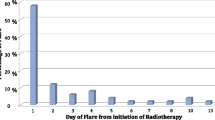Abstract
Goals of work
Radiotherapy (RT) for palliation of pain due to bone metastases (BM) is effective but underutilized likely due to the traditional practice of separate clinic visits for consultation, treatment planning, and RT delivery. However, recent evidence proves one RT treatment is as effective as multiple for analgesia, enabling investigation of an alternative model of RT delivery, the rapid access palliative radiotherapy program (RAPRP).
Materials and methods
Prior to the start of the program, needs assessment was performed to determine the composition of the optimal team. Screening tools were implemented to streamline holistic, multidisciplinary assessment. An advertising strategy, treatment and research protocols, and mechanisms for patient feedback were established. After RAPRP implementation, patient outcomes such as symptom relief were tracked.
Main results
Eighty-six patients with painful BM were referred over the 25-week pilot. Median age was 69.9 years; 64% had prostate cancer, and median performance status was 70. Patient-rated pain was on average 6.1/10 at baseline, improving to 2.6/10 by week 4 post-RT. On average, 6.2 symptoms were reported (baseline) compared to 5.2 (week 4). Team members assessed 10–100% of patients and were successful in stabilizing or improving all symptoms in >75% contacted at week 4. One hundred percent of patients surveyed were satisfied with their experience.
Conclusions
Early needs assessment was advantageous in determining the optimal team and methods of assessment for our ‘one-stop’ BM clinic. This approach was successful in improving pain and other symptoms, and the convenience of seeing multiple providers on 1 day was appreciated by the patients.





Similar content being viewed by others
References
Anderson F, Downing G, Hill J, Casorso L, Lerch N (1996) Palliative performance scale: a new tool. J Palliat Care 12(1):5–11
Andersson L, Sousa P (1998) An innovative way of caring: palliative radiation therapy rapid response clinic. Can Oncol Nurse J 8(2):146–147
Bradley N, Davis L, Chow E (2005) Symptom distress in patients attending an outpatient palliative radiotherapy clinic. J Pain Symptom Manage 30(2):123–131
Bruera E, Kuehn N, Miller MJ, Selmser P, Macmillan K (1991) The Edmonton Symptom Assessment System (ESAS): a simple method of assessment of palliative care patients. J Pall Care 7:6–9
Chow E, Harris K, Fan G, Tsao M, Sze W (2007) Palliative radiotherapy trials for bone metastases: a systematic review. J Clin Oncol 25(11):1423–1436
Chow E, Fung K, Bradley N, Davis L, Holden L, Danjoux C (2005) Review of telephone follow-up experience at the rapid response radiotherapy program. Support Care Cancer 13(7):549–553
Chow E, Wong R, Connolly R, Hruby G, Franssen E, Fung K, Vachon M, Andersson L, Pope J, Holden L, Szumacher E, Schueller T, Stefaniuk K, Finkelstein J, Hayter C, Danjoux C (2001) Prospective assessment of symptom palliation for patients attending a rapid response radiotherapy program: feasibility of telephone follow-up. J Pain Symptom Manage 22(2):649–656
Chow E, Wong R, Vachon M, Connolly R, Andersson L, Szumacher E, Franssen E, Danjoux C (2000) Referring physicians’ satisfaction with the rapid response radiotherapy programme. Survey results at the Toronto—Sunnybrook Regional Cancer Centre. Support Care Cancer 8(5):405–409
Danjoux C, Chow E, Drossos A, Holden L, Hayter C, Tsao M, Barnes T, Sinclair E, Farhadian M (2006) An innovative rapid response radiotherapy program to reduce waiting time for palliative radiotherapy. Support Care Cancer 14(1):38–43
Fainsinger R, Nekolaichuk C, Lawlor P, Neuman C, Hanson J, Vigano A (2005) A multicentre validation study of the revised Edmonton Staging System for classifying cancer pain in advanced cancer patients. J Pain Symptom Manage 29(3):224–237
Fairchild A, Ghosh S, Yip E, Bates J, Poon W, Severin D (2007) Patient satisfaction with the palliative radiotherapy process. Support Care Cancer 15(6):744–745 Abstr
Fitzgibbon E, Samant R, Meng J, Graham I (2006) Awareness and use of the Rapid Palliative Radiotherapy Program by family physicians in Eastern Ontario: a survey. Curr Oncol 13(1):27–32
Haddad P, Wilson P, Wong R, Williams D, Sharma N, Soban F, McLean M, Levin W, Bezjak A (2003) The success of data collection in the palliative setting—telephone or clinic follow-up? Support Care Cancer 11(9):555–559
Huang J, Zhou S, Groome P, Tyldesley S, Zhang-Solomans J, Mackillop W (2001) Factors affecting the use of palliative radiotherapy in Ontario. J Clin Oncol 19(1):137–144
Kirkbride P, Barton R (1999) Palliative radiation therapy. J Pall Med 2(1):87–97
Mackillop W (1996) The principles of palliative radiotherapy: a radiation oncologist’s perspective. Can J Oncol 6(1):5–11
Mackillop W, Zhou Y, Quirt CF (1995) A comparison of delays in treatment of cancer with radiation in Canada and the United States. Int J Radiat Oncol Biol Phys 32(2):531–539
Ottery F (1996) Definition of standardized nutritional assessment and interventional pathways in oncology. Nutrition 12(1 Suppl):S15–S19
Samant R (2006) How should we describe the benefits of palliative radiotherapy? Curr Oncol 13(6):230–234
Schag CC, Heinrich RL, Ganz PA (1984) Karnofsky performance status revisited: reliability, validity, and guidelines. J Clin Oncol 2:187–193
Wu J, Monk G, Clark T, Robinson J, Eigl B, Hagen N (2006) Palliative radiotherapy improves pain and reduces functional interference in patients with painful bone metastases: a quality assurance study. Clin Oncol 18(7):539–544
Acknowledgments
The authors wish to acknowledge Dr M Parliament, S Eberle, E Yip, W Poon, and J Bates for assistance in the RAPRP clinic implementation, as well as all referring physicians for their support.
Presented in part in poster form at the Canadian Hospice Palliative Care Association meeting, Nov 4–7, 2007, Toronto, Ontario, Canada.
Conflict of interest statement
There are no conflicts of interest to declare.
Author information
Authors and Affiliations
Corresponding author
Rights and permissions
About this article
Cite this article
Fairchild, A., Pituskin, E., Rose, B. et al. The rapid access palliative radiotherapy program: blueprint for initiation of a one-stop multidisciplinary bone metastases clinic. Support Care Cancer 17, 163–170 (2009). https://doi.org/10.1007/s00520-008-0468-3
Received:
Accepted:
Published:
Issue Date:
DOI: https://doi.org/10.1007/s00520-008-0468-3




